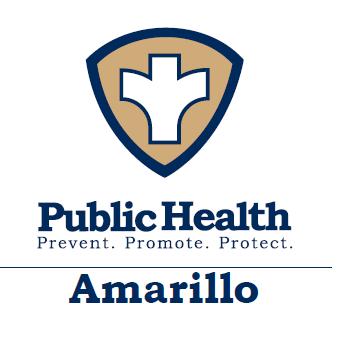
City of Amarillo Department of Public Health Bi-City/County
Health District
The City of Amarillo Department of Public Health Communicable Disease program (CD program) is responsiblefortheinvestigationandanalysisofdiseasetoprotectcitizensinPotterandRandallcounties.
Table 1. 2016 – 2017 Selected Notifiable Conditions Reported and Residing in Potter/Randall Counties
*Started on latent TB therapy from City of Amarillo Department of Public Health TB clinic. ** Flu A and B are lab-confirmed only. Influenza report represents “season-to-date” cases rather than year-to-date.
Vaccine
Even though most infants and toddlers have received all recommended vaccines by age 2, many underimmunizedchildrenremain,leavingthepotentialforoutbreaksofdisease.Manyadolescentsandadults are under-immunized as well, missing opportunities to protect themselves against diseases such as Pertussis,influenza,andpneumococcaldisease.(CDC)
The City of Amarillo Department of Public Health Immunization program offers low or no cost immunizations to children and adults, and frequently uses the Mobile unit to travel around Potter and Randallcountieshostingimmunizationevents.

Enteric Diseases
Enteric diseases enter the body through the mouth and intestinal tract and are usually spread through contaminated food and water or by contact with vomit or feces. Good hand washing and proper food preparation is the best way to avoid these diseases. Common symptoms include: headache, stomach pain,diarrhea,nauseaandsometimesvomiting.(CDC)


Escherichia coli, Shiga-toxin producing Salmonellosis, including typhoid fever
Shigellosis
Viral Hepatitis
Hepatitis means inflammation of the liver and also refers to a group of contagious viral infections that affect the liver. Hepatitis is the leading cause of liver cancer and the most common reason for liver transplantation.(CDC)ThebestwaytopreventHepatitisAandBisthroughvaccination.
Hepatitis A canrangeinseverityfromamildillnesslastingafewweekstoasevereillnesslastingseveral months.HepatitisAisusuallyspreadwhenapersoningestsfecalmatterfromcontactwithobjects,food, ordrinkscontaminatedbythefecesorstoolofaninfectedperson.
Hepatitis B isusuallyspreadwhenblood,semen,oranotherbodyfluidfromapersoninfectedwiththe HepatitisBvirusentersthebodyofsomeonewhoisnotinfected.
Hepatitis C is usually spread when blood from a person infected with the Hepatitis C virus enters the bodyofsomeone whoisnotinfected. Today,mostpeoplebecomeinfectedwiththeHepatitisCvirusby sharingneedlesorotherequipmenttoinjectdrugs.
There is effective treatment, but no vaccine for Hepatitis C. The best way to prevent Hepatitis C is by avoidingbehaviorsthatcanspreadthedisease,especiallyinjectiondruguse.(CDC)

Hepatitis A
Hepatitis B, acute
Hepatitis C, acute
Perinatal Hepatitis B Prevention Program
Hepatitis B canbe passed to a newborn during delivery. The Perinatal Hepatitis B Prevention program (PHBPP) case manages Hepatitis B surface antigen (HBsAg) positivepregnant women through delivery, andtheirnewbornsthroughtheimmunizationprocessandpostvaccineserologytesting.
A main goal of the PHBPP is to aid in the prevention of a potentially devastating, but completely preventable illness from affecting any newborn child. Additionally, the PHBPP strives to increase awarenessandreportingsothatallnewbornswhowillbepotentiallyaffectedreceivelivesavingvaccine inatimelymanner.


Invasive Streptococcal Disease
Streptococcalinfectionsarereportabletothe healthdepartment forthree categories - Invasive groupA streptococcus, Invasive group B streptococcus, and Streptococcus Pneumoniae disease. Severe, sometimes life-threatening disease may occur when these bacteria get into parts of the body where bacteriausuallyarenotfound,suchastheblood,muscle,orthelungs.
Thesebacteriaarespreadthroughdirectcontactwithmucusfromthenoseorthroatofpersonswhoare infected or through contact with infected wounds or sores on the skin. Ill persons, such as those who have strep throat or skin infections, are most likely to spread the infection. Persons who carry the bacteriabuthavenosymptomsaremuchlesscontagious.
6 InvasiveStreptococcal(GroupA,GroupB,andStrepPneumoniae)Disease2007-2017


Tuberculosis(TB)iscausedbyabacteriumcalled Mycobacteriumtuberculosis.Thebacteriausuallyattack the lungs, but TB bacteria can attack any part of the body such as the kidney, spine, and brain. If not treatedproperly,TBdiseasecanbefatal.
TB is spread through the air from one person to another. The TB bacteria are put into the air when a person with TB disease of the lungs or throat coughs, sneezes, speaks, or sings. People nearby may breatheinthesebacteriaandbecomeinfected.
TB is NOT spread by shaking someone’s hand, sharing food or drink, touching, bed linens, toilet seats, sharingtoothbrushes,orkissing.
TBbacteriacanliveinthebodywithoutmakingyousick.ThisiscalledlatentTBinfection.Inmostpeople whobreatheinTBbacteriaandbecomeinfected,thebodyisabletofightthebacteriatostopthemfrom growing. People with latent TB infection do not feel sick and do not have any symptoms. People with latent TB infection are not infectious and cannot spread TB bacteria to others. However, TB bacteria becomeactiveiftheimmune systemcan'tstop it fromgrowing. Ifthishappens,thepersonwillgofrom havinglatentTBinfectiontobeingsickwithTBdisease.
The City of Amarillo Department of Public Health TB program diagnoses and manages latent TB. They providecasemanagementanddirectlyobservedtherapyforpatientswithactiveTB.
7.ActiveandLatentTB2007-2017

Sexually Transmitted Diseases (STDs)
Chlamydia is caused by the bacterium, Chlamydia trachomatis, which can damage a woman's reproductive organs. It is the most frequently reported bacterial sexually transmitted disease in the UnitedStates.Under-reportingissubstantialbecausemostpeoplewithChlamydiaarenotawareoftheir infectionsanddonotseektesting.(CDC)
Chlamydia infections in women are usually mild or asymptomatic. Untreated infection can “silently” result in pelvic inflammatory disease (PID) which is a major cause of infertility, ectopic pregnancy, and chronic pelvic pain. As with other inflammatory STDs, Chlamydia infection might facilitate the transmissionofhumanimmunodeficiencyvirus(HIV)infection.Chlamydiaalsocancausedischargefrom thepenisofaninfectedman.
Gonorrhea is caused by Neisseria gonorrhoeae, a bacterium that can grow and multiply easily in the warm,moistareasofthereproductivetract,includingthecervix(openingtothewomb),uterus(womb), and fallopian tubes (egg canals) in women, and in the urethra (urine canal) in women and men. The bacteriumcanalsogrowinthemouth,throat,eyes,andanus.
Infections due to Neisseria gonorrhoeae are a major cause of pelvic inflammatory disease (PID) in the UnitedStates.
Syphilis is caused by the bacterium Treponema pallidum. It has often been called "the great imitator" because so many of the signs and symptoms are indistinguishable from those of other diseases. Many people infected with syphilis do not have any symptoms for years, and remain at risk for late complicationsiftheyarenottreated.
Syphilisispassedfrompersontopersonthroughdirectcontactwitha syphilissore.Soresoccurmainly ontheexternalgenitals,vagina,anus,orintherectum.Soresalsocanoccuronthelipsandinthemouth. Syphilis can NOT be spread through contact with toilet seats, doorknobs, swimming pools, hot tubs, bathtubs, sharedclothing, oreatingutensils. Pregnantwomen withthedisease canpassit tothebabies theyarecarrying.
Figure8-9.Chlamydia,GonorrheaandSyphilis2007-2017


2013-2017
HIV is the human immunodeficiency virus. It is the virus that can lead to acquired immune deficiency syndrome, or AIDS. HIVdamagesaperson’s bodyby destroyingspecificbloodcells whicharecrucialto helpingthebodyfightdiseases.
PeoplelivingwithHIVmayappearandfeelhealthyforseveralyears.However,eveniftheyfeelhealthy, HIV is still affecting their bodies. All people with HIV shouldbe seenon a regular basisby ahealth care providerexperiencedwithtreatingHIVinfectionandpossiblyreceivebeneficialmedications.
Support services are also available to many people with HIV. These services can help people cope with theirdiagnosis,reduceriskbehavior,andfindneededservices.
AIDS is the late stage of HIV infection, when a person’s immune system is severely damaged and has difficulty fighting diseases and certain cancers. Before the development of certain medications, people with HIV could progress to AIDS in just a few years. Currently, people can live much longer with HIV beforetheydevelopAIDS
The City of Amarillo Public Health Department HIV/STD program conducts HIV prevention activities including screening and treatment, partner elicitation, HIV prevention outreach and linkage to support services.

City of Amarillo Department of Public Health Services
Immunization Program
Hours: Walk-inclinicisMondaythroughFriday8am-4pm
Latehoursare8am-6pmonthefirstTuesdayofeverymonth.
Services offered:
$14.85pershotforclientsovertheageof18
$14.85pershot,nottoexceed$30forclients18yearsofageandyounger
Eligiblechildren
o HaveMedicaid(NochargeforchildrenwithMedicaid)
o Noinsurance
o Areunderinsured(hasinsurancethatdoesnotpayforvaccines)
o OrareAmericanIndianorNativeAlaskan
Noonewillbeturnedawayduetoinabilitytopay
Mobileimmunizationunitforcommunityoutreachimmunizationclinics
Vaccinetiters
o HepatitisB-$33.99
o Measles,Mumps,andRubella-$85.09
o Varicella-Zoster-$29.80
STD Program
Hours: MondaythroughFriday8am-5pmbyappt–phonelinesopenat7:45amfor“same-day”appointments.
Services offered:
TestingandtreatmentforSTDs
o STDTesting
Gonorrhea,Chlamydia,Syphilis,andHIV-$20
Trichomoniasis-$8.72
o STDTreatmentis$5
UrinePregnancyTest-$10
Educationontransmissionandprevention
HIV Prevention and Outreach
Hours: MondaythroughFriday8am-5pm
Latehoursare8am-8pmonthefirstTuesdayofeverymonth.
Services offered:
HIVriskreductioncounseling
Referralstoservices
Riskreductionsupplies
TestingandTreatment(seeaboveSTDTesting/Treatmentprices.)
Tuberculosis Program
Hours: MondaythroughFriday8am-11:30amand1pm-4pm
TBskintestsarenotplacedonThursdays
Services offered:
TBskintestingforthepublicfor$15
T-spot/IGRA(TBbloodtest)for$70.84
Treatmentisprovidedatnocosttothepatient
PublicHealthFollow-up
Pleasevisitwww.amarillo.govformoreinformationonanyofourprogramsorservices.
